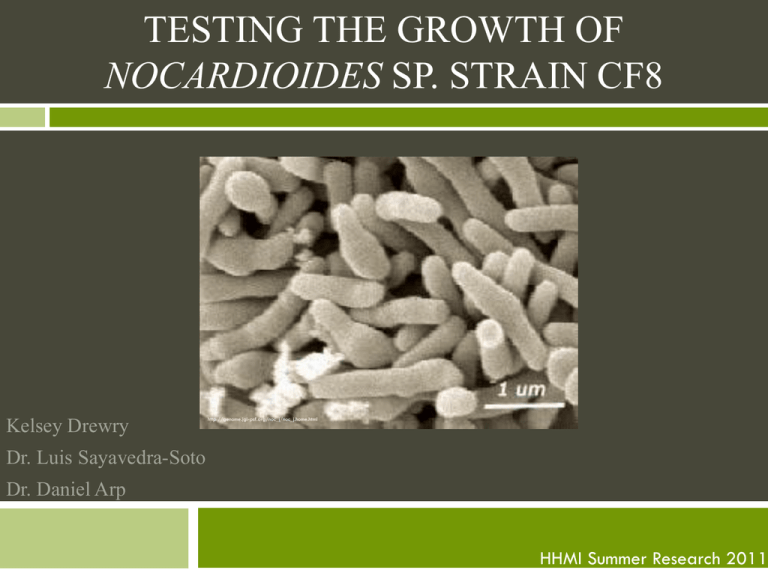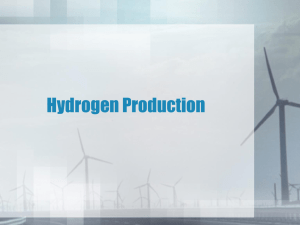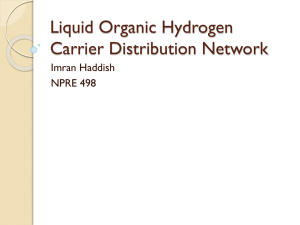Testing the growth of Nocardioides sp. strain CF8
advertisement

TESTING THE GROWTH OF NOCARDIOIDES SP. STRAIN CF8 Kelsey Drewry http://genome.jgi-psf.org/noc_j/noc_j.home.html Dr. Luis Sayavedra-Soto Dr. Daniel Arp HHMI Summer Research 2011 Introduction Fuel Spills and Leaks Bioremediation http://newbridgeblog.com/?tag=fuel-spill-liability http://www.thisland.illinois.edu/50ways/50ways_47.html http://www.gwpc.org/CallToAction/UndergroundStorageTanks.aspx http://news.softpedia.com/newsImage/Experts-Produce-Plastic-Without-Fossil-Fuels-2.jpg/ CF8’s Genome: The Starting Point Hydrogenase Gene BMO Gene Nocardioides CF8 genome Introduction CF8 uses monooxygenase to break down C(2) to C(16) alkanes Monooxygenase has potential to degrade a variety of substrates, including various environmental toxins http://upload.wikimedia.org/wikipedia/commons/9/9d/2Y6Q.jpg Hypothesis Based on the information in its genome, CF8 will be capable of degrading: Hydrogen http://www.myclimatechange.net/default.aspx?Page=Article&SubjectId=42&cat=1&sub=1 Toluene Methyl Tertiary Butyl Ether (MTBE) Objectives Explore the range of substrates that can be oxidized by CF8. Further explore CF8’s potential in bioremediation. http://harrisonstatham.com/start-your-own-website CF8 CF8 CF8 CF8 http://ocean.nationalgeographic.com/ocean/photos/ocean-pollution/ Methods Preparation of basic growth media Growth and maintenance of stock culture Cells grown on media (50 or 250 ml) in 150 or 500 ml bottles at 36 ˚C with shaking Stock cells grown on butane (20-30% headspace) Cells grown in presence of hydrogen have additional 5 ml H2 gas Methods Continued Testing of enzyme activities after substrate addition Addition of substrate, allowance for growth, measurement of substrate degradation using appropriate methods Measurement of substrate degradation Measurement Methods Optical Density (600 nm) Unit substrate degraded per µg protein Gas Chromatography Hydrogen Flame Ionization Detector MTBE Hydrogen Why hydrogen? Hydrogenase is indicated in genome Is it expressed? Does presence of hydrogen stimulate cell growth? Cells (grown with and without presence of H2) centrifuged and resuspended to an OD of approx. 2.0 1 ml aliquots into 8 ml vials, 100 µl H2 added. Gas chromatography used to measure degradation of hydrogen. Hydrogen Continued CF8 Grown in Butane CF8 Grown in Butane + H2 2500 Killed Cells 2500 2500 H2 H2 2000 2000 2000 O2 O2 O2 1500 Peak Area Peak Area 1500 Peak Area 1500 CO2 H2 1000 1000 1000 CO2 500 500 500 CO2 0 0 0 0 50 100 150 Time After Innoculation (min) 200 0 50 100 150 Time After Innoculation (min) 200 0 50 100 150 Time After Innoculation 200 Hydrogen Tentative Conclusions • • Hydrogenase is expressed by CF8. Cells grown in butane+H2: • • consume more H2 than cells grown in butane alone. Cells grown in butane alone: • • consume more O2 than cells grown in butane+H2. produce more CO2 than cells grown in butane+H2. Hydrogen Continued Degradation of Hydrogen by CF8 110 Killed Cells 100 µmol Hydrogen in Vial 90 80 70 60 Control (Killed Cells) 50 Cells Grown in Presence of H2 Cells Grown on Butane Alone 40 30 20 10 0 0 2 4 6 Hours After Addition of Hydrogen 8 Hydrogen Tentative Conclusions Cells grown in presence of hydrogen degrade hydrogen at a rate of 0.45 µmol/hr · mg protein Cells grown in butane alone degrade hydrogen at a rate of 0.32 µmol/hr · mg protein These results suggest that the hydrogenase must be induced by the presence of hydrogen to become effective. Future Work with Hydrogen Why does CF8 have the hydrogenase? Stimulation of growth? Anaerobic Growth? Nitrate/nitrite and bicarbonate. Toluene Used as octane enhancer in gasoline, also in paint, paint thinners, rubber, etc. Leaches into soil and groundwater when disposed, and with underground leaks (especially during transfer and storage of fuel) http://www.gwpc.org/CallToAction/UndergroundStorageTanks.aspx Toluene Investigation Cells grown with 5 mM toluene for about 7 days No butane or alternate substrate, cells grow on toluene alone. OD equivalent to cells grown on butane. Since CF8 grows on toluene alone, it must have a toluene oxidizing enzyme, possibly a toluene monooxygenase. Toluene Investigation Is the enzyme induced by presence of toluene? Comparison of growth of cultures on toluene inoculated with butane grown and toluene grown cultures. What biochemical pathway is CF8 using to break down toluene? Growth of CF8 on intermediates of known pathways What are the products of toluene degradation by CF8? Are they less harmful to the environment than toluene? MTBE Methyl Tertiary Butyl Ether (MTBE) Highly produced gasoline additive (200,000 barrels per day in 1999) Helps oxygenate gas, burn more completely and reduces harmful tailpipe emissions FDA studies indicate MTBE may be a carcinogen Affects taste/smell of water at 5-15 µg/L (5 ppb) Travels faster and further through water supply than many other chemicals due to solubility http://upload.wikimedia.org/wikipedia/commons/a/a9/MTBE-2D-skeletal.png MTBE Work Cells grown on butane for about 2 days Washed and resuspended with media to an OD of approx. 2.0 Small, varying concentrations of MTBE added Degradation measured with FID (2 µl injections) http://www.gchplc.com/gas-chromatography.html MTBE Work Degradation of MTBE by CF8 20 Killed Cells 19 18 17 µmoles MTBE 16 Live Cells 15 Control (Killed Cells) Mean Live Cells 14 13 12 11 10 0 1 2 3 Hours After Addition of MTBE 4 5 6 MTBE Tentative Conclusions MTBE is degraded by CF8. The average rate of MTBE degradation is 50 nmol/hr · mg protein Conclusions CF8 can degrade hydrogen, toluene and MTBE. CF8 can use toluene for growth. CF8 has potential in bioremediation. With Further Research: Products and toxicity of toluene and MTBE degradation Acknowledgements Howard Hughes Medical Institute Cripps Fund Luis Sayavedra-Soto Dr. Daniel J. Arp Dr. Kevin Ahern Members of Arp Lab








